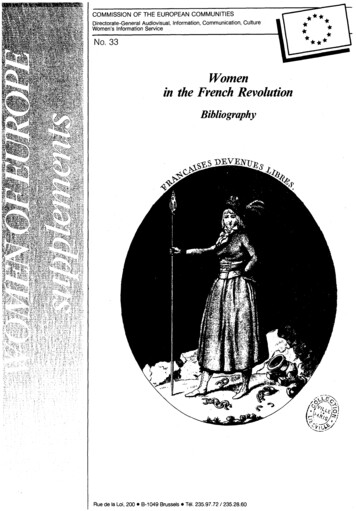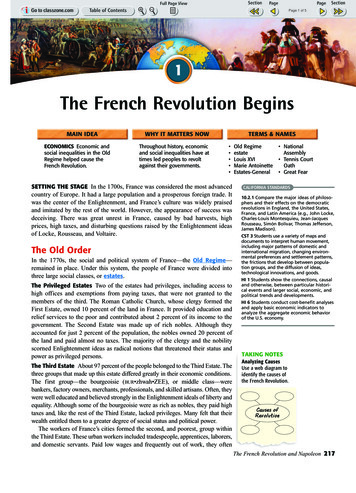
Transcription
COMMISSION OF THE EUROPEAN COMMUNITIESDirectorate-General Audiovisual, Information, Communication, CultureWomen's Information ServiceNo. 33Womenin the French RevolutionBibliography·. ;Rue de Ia Loi, 200 B-1049 Brussels Tel. 235.97.72 I 235.28.60
The contents of this publication do not necessarily reflecl t the officialopinions of the institutions of the European Communities.1'Reproduction authorised with mention of the soutce.iWritten acknowledgement is always welcome.
WOMEN IN THE FRENCH REVOLUTION (1789)IBibliographyYves BessieresandPatriciaNi dzwieckiofThe Institut pour le Developpement de l,Espace CulturelEuropeen(Institute for the Development of the European Cultural Area)January 1991
The celebration of the bicentennial of ·the French Revolution·was required to draw historians' at tent ion to the r'ole playedby women in the French Revolution.The histories writ ten by men often hide women in dark folds,erase them, or are unaware of their presence.This research isan attempt to give women their rightful place in History.Fausta Deshormes la Valle
Table of ContentsIp.1j. . p.2p.3p.9Foreword . · · · · · · · · · · · · · · · · · · · · · · · ·1 · · · · · · · The .Judl(llen t of History . Women and History . . '- . · · · · · · · · · · · · · · · ·1The Origins of the Women's Movement· · · · · · · · · · 'l' ·······IWomen and Political "Feminism" . . , . . p. 12Right . .p. 14Women's Contribution to the Revolution j . .p. 18After the Revolution . . . . . . . . . . . . . . . . . . . . . . . . . .l . . p. 23Glossary . . . . . . . . . . . . . . . . . . . . . . . . . . . . . . . . . . . . . . . . . . . . . . . . p.1:.Olympe de Gouges' Declaration of Women'sBrief chronology . . . . . . . . . . . . . . . . . . . . . . . . . . . . . .Bibliography . . . . . . . . . . . . . . . . . . . . . . . . . . . . . . . . . .I11.27p. 33. . . . . . . . . . p. 34
p. 1FOREWORDNo other period of France's history is as controversial as the 1789Revolution. It was and still is controversial. One need only think of therecent bicentennial celebration and the polemics that ensued to beconvinced of this. It is doubtless because we still feel its effects, likethose of a trajectory that has not ended and is perpetuated even today bythe issues of human rights (a term to be preferred over the morerestrictive "Rights of Man", since it embraces both women and men) andfreedom, which are basic legal principles in Europe's democracies.TheFrench Revolution will have, among other things, taught the world's peoplesthat it is not enough to conquer freedom.Years of rupture are necessaryto learn how to live together.The notions of rights and freedom born of the revolutionary tormenttriggered a mechanism of self-perception, i.e., that the individual is aperson belonging toa gender, a sex.Consequently, women are seen asdemanding the rights that are specific to their persons, to theirfunctions, and the places they want to occupy in the emerging new society.Actually, women rapidly served as alibis, then, accused of "abusing"freedom, they became the true victims of the revolutionary tragedy, forthey won, then lost, all rights as soon as they had been freed of thebondage of the former regime, under which they had nevertheless made somegains.After that, they were put in a position of total dependence ontheir husbands, who, having overthrown a king, would set up an even morerestrictive empire for women.In 1989 it was interesting to draw the parallels that existed between theFrench Revolution of 1789 and the end of our century, especially thoserevealed by an analysis of the differences in law for men and women.Olympe de Gouges' Declaration of Women's Rights ( 1791) wanted to spark arevolutionary questioning of society.When this period is examined 200years later we see that a social history of women since the Revolution isstill lacking.To this end we have tried to provide investigators of both sexes with alengthy bibliography (close to 1,000 references) of works concerning aboveall the social history of women from the ancien regime to the Empire.Inthis way we show that History with a capital H turned its glance first ofall towards those women who hated the Revolution and neglected the womenwho served the Revolution's ideals.Far from writing a complementaryhistory, we have chosen to make our modest contribution by proposing alarge compilation of studies, theses and works concerning the Revolutionand its general history.The late date of this publication is deliberate.We had to wait for thepublication of some 1, 000 works between 1986 and 1990 and the proceedingsof the eight European seminars devoted to this subject if our bibliographywas to be worthwhile.
p. 2Our aim is thus not to analyse the consequences for Euro e of the movementsborn of the French Revolution, but, on the contrary, to draw attention, aswe did in Wgm. D. . . . . ;!,ml,.MY.:. .!. 9 (Supplement W 22 of W.9 1:J. D. i.9f . .Y.:.r.9P ), to theplace and role of women in history.We have emrhasised the worksconcerning feminism and politics, the arts and culture, morals and societyand religious life. In doing so, we hope to raise int rest among Europeanresearchers so as to produce new studies, notabl studies on thecontributions made by the women of the French Revolutf· on to Europe.Wehope that this bibliography will help all those who ish to delve moredeeply into one of the most troubled periods in the his ory of a people andits conquest of human rights.i***THE JUDGMENT OF HISTORYIWe possess close to 1, 500 documents writ ten by wi tnJsses of the FrenchRevolution.Few of them concerned women, especiall since the 17,500victims of the guillotine--officially, 166 of them 4ere women---did notalway.s have the time to write their memoirs and their last letters did notalways reach their destinations. They is why we had to rejoice to have thememoirs of Mme Roland who, in judging her epoch, wr te, "Everything iBdrama, novel, enigma in this still revolutionary exis ence."How, then,can we not be surprised by the contradictions that we find, expecially inthe writings of those who verily give testimony about tne history that theylived?IThe first historians of the French Revolution seized thty documents steepedin impassioned judgments and the testimony (sometimes 70 years later, atthe dawn of the 1848 revolution) of those who too, part in the 1789Revolution and took from them everything that might se ve their own idealsor political leanings.I!Actually, in the time of Michelet--one of the majorj historians of theFrench Revolution--two readings of the events overlapp d, due to the birthof the scientific analysis of the documents andl the psychologicalinterpretation of the facts."We knew everything, J!fe did not know, wewanted to explain everything, to guess everything, deep causes were seenel'en in indifferent things," Michelet wrote.It is hus not surprisingthat this epic inspired the romantic historians of thelestoration and ulyMonarchy.All of them expressed in their works eith r obvious politicalhostility, as did Burke and Taine, counter-revolutio, ary historians whoexecrated "the crowds of brigands, thieves, assassins!, the dregs of thepopulation" and everything that they represented, or Mprtimer-Ternaux, whotreated the Revolution from the standpoint of an ari tocrat in 1792 whoremembered only the Terror and its exactions.The FI1ench Revolution wastoo close to be useful in shedding light on the immediat:e future of France.IWhy did Michelet publish the first two volumes of pis history of therevolution in 1847? Why did Lamartine publish his lfj, §.t.r.:f.r.lf}.if.lf}. . Jl.i.t.9.P.tfi.!!.§that same year?Why did Louis Blanc publish the irst volume of hishistory of the Revolution and Alphonse Esquiros p blish in 1848 his.!!.:!.§.t.P.:f.r.l!:!.r!.f!§.t1.C .IJ.t.?.:I1!J.?r.4. ? Because France was on thr eve of the 1848revolution and these historians were not merely writi:qg in the fabric ofthe history of politics or events, they had a presentliment of the sombredestiny of a people who, in forgetting its past, was hiding its scars.Ii
p. 3In writing the history of the 1789 Revolution under the weight of theevents of 1847, the historians who were witnesses of their time paintedthis new revolution heading to its inevitable doom from the vantage pointof political history only, for until then the French Revolution had neverinspired a study of morals or standards of behaviour.As for the rest,Balzac in his preface to Th. . . . R .l.l. . . QQ 9y, made this reproach in 1848, forthe real revolutionary driving force of 1789--the mob and the populace,composed mainly of women, and their tragedy and humanity--was left lmostcompletely aside.Who stormed the Bastille? · "The people, the wholepeople," Michelet would reply.The majority of this people, likened byTaine to a "beast sprawling. on a crimson carpet," consisted of desperatewomen.It is remarkable that, historically, the notion of crowds andmasses has irremediably been associated with women, even though men werethe ones who fired the first shots on those days.Yet of what were the crowds that marched on Versailles and overthrew themonarchy made up? Mostly women.Who led them?The women of the marketdistrict (la Halle). On 20 June 1791, after the king's flight, the womendeclared, "Women were the ones who brought the king back to Paris and menwere the- ones who 1 et him escape".Were women indeed the vectors of therevolutionary uprising of the people?Yes!This is unquestionable.Michelet, who admired women and sometimes exalted their virtues or courage,understood their powerful motivations. "W0.111en were in the forward ranks ofour revolution," he wrote."We should not be surprised at this; theysuffered more.The greatest adversities are ferocious, they strike theweak hardest; they mistreat children and women much more than .they do men."Despite this, few women were remembered by history, although much waswritten about their roles in the Revolution and their impassioned rages.Sublime or fishwife, heroines or "crossroads Venuses", furies or hystericalindividuals, while they were undoubtedly all this, they were also mothersand wives who suffered from being women under the ancien regime (oldregime).The Revolution, we have said, was a romantic epic and it is certain thatwomen exacerbated the pens of the 19th-century historians to the confinesof legend, to the point that, in relegating women to the anecdotes ofhistory, the historians turned women into victims of the Revolution andvictims of History in alternation.What of the sketchy social justice conquered at the price of much bloodwould remain under the Directory? Nothing, or almost nothing!The majorlesson to be remembered is that these women attempted to conduct thewomen's revolution alone. The history of men will never forgive them this.* **WOMEN AND HISTORYLet us then read history.Mirabeau, wanting to offer the throne to theDuke of Orleans, fomented trouble and used the Duke's money to pay thetroublemakers whom Choderlos de Laclos, the Duke's grey eminence, recruitedat Palais-Royal. "Twenty-five louis," Mirabeau used to say, "will get youa very nice riot."While suggesting to the French guards that they go
p. 4fetch the King at Versailles and bring him back to Paris they had the ideaof paralysing the flow of food supplies to Paris fotwo days beforesetting the women on Versailles. After all, the soldiers would not fire onwomen. Louis XVI himself would meet the insistance of Mbnsieur de Narbonneand the Duke of Guiche, who wanted to call out the gu rd, with cries of"Come, come! orders of war against women? Are you mockin me?"Monday, 5 October 1789, five to six thousand lwomen marched onVersailles, with the women of la Halle leading the way .I Behind . them camethe men. , with the youngest disguised as women. Covered i ith mud, soaked bythe rain and sweat, worn out, drunk, most of these co rse women shriekedthreats at Marie Antoinette.Actually, between 100 a d 150 furies madehistory.Led by Maillard, the women of Pelican Street and les Porcheronsinsulted the bourgeois ladies, devout women, the women torn from theirhusbands' arms or housewives recruited by force when ttiey were not struckor enrolled by the threat of having their hair cut off.l The women packedbefore the royal palace flirted with the soldiers of the/ Flanders Regiment.An unknown woman distributed lxus and gold louis.A orse felled in thesquare (place des Armes) was inunediately cut up by tlese poor, starvingwomen.On1A large number of women, joined by men armed with some 7 0 muskets that thewomen ringleaders had stolen from t.he town hall's arms to res, picks, axes,hooks and iron bars, swarmed into the national assembly, which was housedat the time in the H8tel des Menus-Plaisirs.The Depu ies strove to calmthe women who pushed them about, kissed them, insulted t em, took off theirdresses to dry them, lay down on the benches, vomited, sang or brayed "Downwith the cloth/church party, not so many speeches,read, meat at sixsols!"Taine depicted them as an army of "laundresses, begg. s, barefoot women,coarse women solicited for several. days with the prom ·se of silver.'"Asfor the men, they were vagabonds, criminals, the dregs of the FaubourgSaint-Antoine neighbourhood, some, according to Count d Fersen, were Swissand Germans.Many sources (about 400) also indicate t.pat many of the menwere disguised as women to discredit them.IIFinally, around six o'clock, the king received a delega ion of five or sixrepresentatives of the "fishwives" led by Louise Cliabry, a worker insculpture and obviously endowed with sensitivity who definitely did riotbelong to their "guild" for she felt "ill at ease" whe she was introducedto the king. The king served them wine and heard them out. Louise Chabryasked the king for that which all the women of the king,om were clamouring,bread and food for the populace, while Louison and Ros lie, fish merchantsat Saint Paul's market, shrieked their demand for Mari -Antoinette's head.The other women, who were few in comparison with the !fish wives, behavedcompletely differently.IIf Burke clothes in public opprobrium the women a.t Vet'rsailles in October.1789, he obviously forgot that these women were dri v n by a spontaneityengendered by the miserable conditions of their lives. ,In no case did theywish for anything during the days at Versailles other! than to bring backthe most precious of objects to Paris, namely, bread. .ad they not gon tofetch it from the very King, Queen and Crown Prince, 1'the baker, bakeressand baker's boy"? Yet, during the celebrations held 9n 10 August 1793 anarc of triumph would be set up in honour of the "heroinjs" of Octo er.
p. 5Here, too, we must destroy one of the many legends of which women were themain victims. Those who distinguished themselves in the riots were neitherin rags nor slovenly, as history has too often suggested. Witnesses of themarchers of 5 October 1789 saw "well-dressed gentlewomen", "women wearinghats" according to Hardy, who added, in describing the women massed in theAssembly at Versailles, "this strange spectacle was made even stranger bythe dress of several of them . who, while wearing rather elegant women'sclothing, had hung hunting knives and half-sabres along their skirts". Thesame day the women forced the beadle of Saint Margaret's church in FaubourgSaint-Antoine to sound the tocsin.His attention was caught by a welldressed woman "who did not seem a commoner". Six women were chosen to givetheir respects to the king and, according to the Marquis de Paroy, "two ofthem were rather handsome" .This does not mean that the others were"slovenly", "in rags" or, as Taine asserts, "the capital seemed to havebeen given up to the lowest of plebians, bandits, vagabonds who were intatters, almost naked", for eyewitnesses of the "coarse clothing of the menand women of the populace" were referring more to the fabric of which theywere made, for lack of means, than their condition or "rag cut".During the food riots of 1793 a report of the Arsenal's commissar mentioned"a woman who was not bad. wearing a negligt§ (dress) of blue cloth with arunning desilfn, a short, black taffeta cape and a gold watch on a silverchain." Yet Agnes Bernard was a "fishwife" at the central market. In anyevent; of the 1, 683 arrests made after the ll Paris riots that occurredfrom 1775 to 1795, none of the 148 women who were arrested fit thedescription given by Burke, "all the unspeakable abominations of the furiesof Hell incarnated in the fallen form of the most debased women."Thedescriptions of women, their clothing and their behaviour, including thatof the populace--' the rabble', as Taine put it--most harshly and unjustlydiscredited the revolutionary mobs, especially the women. Despite evidenceto the contrary, the wealth of testimony and, above all, police reports,"bad habits," the historian George Rude wrote, "are tenacious and thegeneral historian is only too inclined to make up for his shortcomings byusing a convenient, it is true, vocabulary that has been ·consecrated by. tradition but is nevertheless misleading and rather incorrect."On the occasion of the 1789 Estates-General women prepared some 30 files ofgri vances and complaints in which they expressed their demands,oftenanonymously and in highly varied styles, and denounced the condition ofwomen. They asked for the right to vote, to divorce, and to have their ownrepresentatives, but mainly stressed their living conditions and thesuffering they had to endure.The pamphlet "La Lettre au Hoi" reveals the real motive behind theRevolutionhunger: "Your Highness, our latest troubles should beattributed to the high cost of bread'. And this is plain to see: at thattime Paris harboured more than 70, 000 people without work, and a 4-poundloaf of bread cost 12 sous on 8 November 1788, 13 sous on the 28th, 14sous on 11 December, and 14.5 sous in February 1789. It remained at thisprice until the fall of the Bastille. A worker earned between 18 and 20, awoman· between 10 and 15 sous a day.The price of bread was the women'smain demand for, despite token decreases of 1, then 2 sous, a loaf of breadcost between 40 to 80% of a woman's wages.Men lost time waiting in long lines and they blamed the women says GeorgeRude, quoting Hardy's journal: "to have bread, the more hurried men triedto push the women away and even bullied them to be first in line." Thewomen could no longer bear these privations, and to compound their problemsthere w s no fuel left that year and the winter of '88/89 was extremelybitter.
p. 6Each time there was a demonstration for more bread or lower prices, womenled the ranks, and they were always the first target of the inevitablerepression.Doctors noted a .large number of medical ,disorders resultingfrom the intense fear of the times, especially among hildren and women.There was an increase in miscarriages.iIAt the end of the 18th century, 16 to 18% of the French !population lived incities, and the population of Paris alone increased by jl4,000 new arrivalseach year (as an indication there were 28 million French at the time,compared with 9 million in England, and 7 million Russians).There we·reroughly 20 million peasants in France, half of them wo en. Eighty percentof the population were illiterate, and of the other 20%, it should be notedthat women were among the most "cultivated".Some 20 000 water carriers(women and men) wended their way through 900 streets am ng 200,000 cats andas many dogs. Each year the French consumed an avera e of 122 liters ofwine per person, but ate three times less bread than th English. But thiswas all they had to eat, and unfortunately the situation was not new. Morethan 300 revolts preceded the Revolution.In Grenobte on 7 June 1788,called· "tile day" because angry women hurled tiles at garrisoned troops,Stendhal heard an old woman say "I'm in revolt"; she w s hungry. And thelittle money the French had left became worthless withj the· appearance, inNovember 1789, of bank notes or 'assignats" that were e changed at the rateof 50 pounds of money for 100 pounds of assignats.· .·1Once Louis XVI abolished censorship, Axel de Fersen w ote to his father:"All minds are in ferment.And all people talk about ts the constitution.Now women are getting involved, and you know as well a I do the influencethey have .in this country."iIt is true that insurrectional and popular movements rkllied a large partof the classes which we now call disadvantaged.Asresult women, whohave always been among the least advantaged of society, were at the heartof movements that often degenerated into street fight .Very few women,however, actually led uprisings.L; · We now have the three lists of the Victorious of the B. tille ( "Vainqueursde la Bastille that were approved by the Constitution ! Assembly in 1790.These lists contain the names of those whose active articipation in thestorming of the Bastille could be proven. One list--d awn up by StanislasMaillard, secretary of the Victorious--contains the n es, addresses andprofessions of 662 participants;there is only one woman: MarieCharpentier, wife of Hanserne, laundress from the pari h of St. Hippolytein the Faubourg St. Marcel.Michelet also wrote of another woman who,dressed as a man, would later become an artillery cap ain, but we find notrace of her in these lists. Many of the victims werelwomen and children.Working behind the lines, they ensured the constant /supply of food andarms.IIWe know neither the names of the rioters nor the number of dead in theuprising of 28 April 1789, known as the R veillon Afffair, which precededthe Bastille.Historians have never agreed on . the ,bact number, whichvaried from 25 to 900 dead.On the other hand, thete is no longer anydoubt about the r'8le of agitators, most likely in the pay of the Duke ofOrleans.On this day, in the Faubourg St. Antoine, ue de Montreuil, acrowd attac ed the R veillon wallpaper factory. The or gin of this riot isgenerally attributed to the price of bread, but the Du hess of Orleans wascheered as she went by while .other nobles were mistre ted and robbed.Inany case, we have the name of just one woman, Marie-Jeanne Trumeau, who wasrecognised as one of the leaders and condemned to be habged at the Place dela Greve. She was pardoned because she was pregnant.·
p. 7Among those who participated in the attack of 10 August 1789, 90 Federatesand close to 300 Parisian sectionnaires were killed or wounded. There wereonly 3 women among them, including Louise-Reine Audu, who was also listedas participating in the events of 5 October. 600 Swiss soldiers lost theirlives in one day.Nevertheless, we should not conclude that women wereexempt from combat, that they led no revolts or that they were passivewitnesses to the Revolution. Who could believe it was possible to escapethe legitimate anger of the fishwives of the Halle? And imagine trying to.curb the simmering hatred of 70,000 prostitutes (without counting those whogave in to the "promiscuity" of the times, food had to be found one way oranother). And what about the women out of work, the poor and diseased, thebeggars and battered women? And even when we deplore the acts of vandalismand cruelty, we also know that women, through their devoted efforts, savedmany more lives than they took.They hid priests who refused to swear fealty to the Republic, fed armies,all the armies - Royalists, Federates, and Catholics.In their battlecries and in their acts they incited the crowds to loot and murder, but theatrocities attributed to women are so rare that history remembers them. InMontauban the women reached the limits of cruelty, but this was the solecase in the whole Revolution. We shall come back to this later.It is also surprising to see how history and legend intertwine when youspeak about revolutionary women. Th roigne de M ricourt- is undoubtedly thesorriest example, with all due deference to Baudelaire.The famous."Amazon" was not at the Bastille as the Goncourt brothers wrote, nor wasshe at the Invalides as Lamartine claimed. It is unlikely she participatedin the march on Versailles, and it is not certain, despite Michelet, thatshe played any rale whatsoever in the events of October, which she always'denied.Eccentric and outspoken, she attracted many enemies, but wasmainly reviled by Royalist newspapers, like most of the other womenpatriots.The murder of the journalist Suleau (10 August 1789), who had covered herwith sarcasm in the A. t. §.Q §.AP.§.t.r . newspaper, was less a revolutionaryact, as Th roigne de· M ricourt constantly preached, than one of personalreprisal. Her deed was not so much an example of "female hysteria" as itwas the product of one woman's deranged mind. Her political influence wasrestricted to founding the Club des B111ies de la Loi (Club of Women Friendsof the Law), which never had more than 12 members. Th roigne de M ricourtdied insane.More than anything, she was a victim of the counterrevolution and a victim of History's injustice .She was dismissed as a hysteric, like so many other women. In itself thisis not surprising, for at the time this psychic manifestation was stillconsidered an excess of morbid feminine eroticism.Notwithstanding,Michelet and Carlyle devoted· reams of paper to the excesses of feverishmale hysterics.On 10 August 1792, Claire Lacombe, an actress who arrived in Paris from t eFrench provinces in 1792, and Pauline L on, former chocolate-maker,received civic laurels, like Theroigne, for their participation in the fallof the Tuileries.In May 1793 these women founded the SocieteRepublicaines-Revolutionnaires (Society of Revolutionary Republican Women),the most famous women's revolutionary club of the time. With Pauline L onas its president, the club i talled itself in the library of the JacobinsClub, and adopted strict rules of procedure.The RevolutionaryRepublicans' primary mission was to foil the aims of the republic'senemies.Their power was most evident in the streets. Participating in
p. 8.people's demonstrations that led to the fall of the Gir dins, these ardentpartisans of the Jacob ins paraded in the streets wear· ng red bonnets andpantaloons, harassing the Girondins, and silencing them n the galleries ofthe National Convention and public me tings./On 2 June the Jacobins, with the crowd's assistance, threw the 29 GirondinDeputies out of the National Convention.The Revolutionary Republicansguarded the entry so that no members could leave to prot st the act.The Girondins considered these women to be despicableIn hismemoirs, Buzot described them as pariahs, women of t e streets, "femalemonsters with all the cruelty of weakness and all the vi es of their sex'.In July and August, the Revolutionary Republicans wel e accepted on thecouncils of the Parisian sections.They even managed tb pass a law, aftervigorous campaigning, that obliged women to wear the r'volutionary cockadein public.Like Th roigne, Claire Lecombe called foil the right to beararms.Her frequent interventions in Jacobins Club (iebates and at theNational Assembly earned the wrath of at least one me ber, who said thatthis woman meddled in everything.Another was convinc d she was an agentof the counter-revolution. Like Constance Evrard (23 y ars old, cook, Clubdes Cordeliers), who was arrested on 17 July 1791 for i sulting the wife ofa National Guard militiaman who had participated i t the Champ-de-Marsmassacre,these women were considered , dangerousecause they wereoutspoken.The Revolution, after giving women the ri ht to speak, wouldsoon silence them.!n 1793, there was only .one vote again t outlawing wrmen's clubs, whichwere considered to be dangerous for the republic. -The deputies were askedthree questions:1I - Should assemblies of women be allowed in Paris?- Should women be allowed to exercise political dghtspart in the affairs of State?- S.hould they be allowed to deliberate in politicalsocieties?.nd take an active1ass ciationsor popular.JThe Convention members replied with a resounding "nothus sealing the"political death" of women as the Civil Code was prtparing their. "civicdeath".',1IThe women did not take long to react. Wearing their amousred bonnets, aIdelegation led by Claire Lecombe went before the Paris Council.However,the Council president, Pierre Chaumette, denounced them saying: "It ishorrible--unnatural--for a woman to want to become a lman . Since when hasit been decent for women to abandon their pious housJhold tasks and theirchildren s cradles to meet in public places yelling frbm the galleries?""Impudent women who want to turn themselves into men, Jon't you have enoughIalready? What more do .vou want? Your despotism is the only force we cannotresist, for it is the despotism of love, thus the work of nature. In thename of nature itself, stay as you are.Instead of nvying our perilous,busy lives, you should be content to help us forgetthis at hame in ourfamilies where we can rest our eyes with the en anting sight of ourchi 1dren made happy through your cares.".1a1
p. 9Fierce rhetoric when you know the fate of the women to whom he preached.Mme Roland and Olympe de Gouges were already dead; Claire Lecombe andPauline Leon had no choice but to give up their struggle if they did notwant to follow in their steps. And this is what they did. For a time thewomen of the provincial clubs continued to take care of the poor, the sickand the needy, but only passively, as all initiatives were discouraged.The Terror executed blindly.Robespierre' s "virtuous republic" cleared the situation up by clearingpeople out. Prostitutes were banned from the streets of Paris, women weresent back to their homes, and only a few exceptions escaped this ostraGismfrom public life: a
women exacerbated the pens of the 19th-century historians to the confines of legend, to the point that, in relegating women to the anecdotes of history, the historians turned women into victims of the Revolution and victims of History in alternation. What of the sketch










